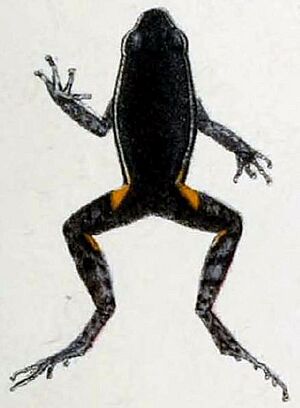Ameerega hahneli facts for kids
Quick facts for kids Ameerega hahneli |
|
|---|---|
 |
|
| Conservation status | |
| Scientific classification | |
| Synonyms | |
|
Dendrobates hahneli Boulenger, 1884 "1883" |
The Ameerega hahneli is a small, colorful frog that belongs to the Dendrobatidae family. This family is also known as the poison dart frogs. You can find this frog in the Amazon rainforest. It lives in countries like Brazil, Bolivia, Peru, Ecuador, Colombia, Venezuela, Guyana, French Guiana, and Suriname. This frog is named after Paul Hahnel, who was the person who first collected these frogs for scientific study.
Contents
Understanding Ameerega hahneli
Scientists often study how different animals are related. The Ameerega hahneli frog has sometimes been confused with another frog called Ameerega picta. Some scientists even thought they were the same species. However, new research helps us understand these frogs better. For example, a similar frog, Ameerega altamazonica, was once thought to be the same as Ameerega hahneli. But now we know it is a separate species. This shows how scientists keep learning more about the animal kingdom!
What Does Ameerega hahneli Look Like?
These frogs are quite small. Male frogs are about 17 to 19 millimeters long. That's less than an inch! Female frogs are a bit bigger, measuring 19 to 22 millimeters. Their backs and legs are usually brown. They might have small black spots.
The sides of their bodies are black. A thin white or cream-colored line runs along their back from their nose to their groin. They also have a white or cream-colored stripe on their upper lip. Their belly is blue with black patterns. You can also see yellow-orange spots on the underside of their arms and legs. Their eyes have a dark brown iris.
How Do Ameerega hahneli Frogs Reproduce?
Male Ameerega hahneli frogs are very protective of their space. They have a special call to warn other males to stay away. This call is a long series of short "peep" sounds. When a male wants to attract a female, his call is similar but shorter, with only three notes.
Female frogs lay their eggs on the ground, usually among fallen leaves. They can lay between 6 and 33 eggs. These eggs are dark in color. After 4 to 16 days, the eggs hatch. The baby frogs, called tadpoles, then climb onto their father's back! Their dad carries them to a nearby creek or stream.
The tadpoles need moving water to grow. They are brown with a flat body and a long tail. After about two months, the tadpoles go through metamorphosis. This is when they change from a tadpole into a tiny frog.
Where Do Ameerega hahneli Live?
The Ameerega hahneli frog is quite common in most parts of the Amazon rainforest. However, it is not as common in the Guianas region. These frogs live on the forest floor in tropical rainforests. They often hide under fallen palm leaves, branches, or in small open areas of the forest.
They are active during the day. At night, they find shelter in low plants to sleep.
Is Ameerega hahneli Endangered?
Even though some areas might lose their natural homes due to habitat loss, the total number of Ameerega hahneli frogs is stable. This means the species is not currently considered threatened. It's good news that these fascinating frogs are doing well in their natural environment!



